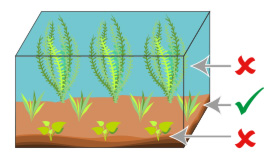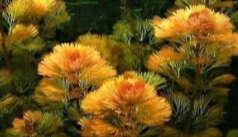

Alternative species (click on the thumbnail to see the card)
Names
Scientific name
Cabomba aquatica
Common name
Giant cabomba
Origin

Origin: South America (Mexico, Brazil)
Ideal fertilization

CO2: 20-40mg/l
Nitrates (NO3): 10-50mg/l
Phosphates (PO4): 0,1-3mg/l
Potassium (K): 5-30mg/l
Iron (Fe): 0,01-0,5mg/l
Group

Cabombaceae
Kind

Stem
Parameters

T°: 15 to 28°C or 59 to 82°F
pH: 6.5 to 7
Hardness: 6 to 10°dGH
Difficulty

Hard
Lighting

Strong
Size

100cm (40")
Plantation

Middle
Growth

Fast
Presentation
Who is the Giant cabomba?
Presentation
Who is the Giant cabomba?
With a pretty soft green and a rich appearance, this "aquatic fan" is not lacking in charm! This species of plant is also very popular with aquarium hobbyists.
Its long stem has leaves made up of several hundred filiform segments (about 200 to 600). The colours of its segments range from light green to a whitish colour.
When the plant grows tall enough, the upper part of the plant becomes "soft" and undulates gracefully with the current.
Planting and maintenance
How to plant and maintain the Giant cabomba?
Planting and maintenance
How to plant and maintain the Giant cabomba?
Cabomba aquatica is a freshwater plant. Test the hardness of the water in your aquarium before you buy it, as it does not tolerate hard water, in which it will eventually wither away no matter how hard you try. The correct hardness for this plant is 6 to 10°dGH. It is therefore not suitable for all aquarium profiles!
Cabomba aquatica will need plenty of light in order to flourish. In fact, the more light it receives, the bushier and denser it becomes. Install it away from other plants that might hinder the light from reaching its foot. In addition, it will benefit from a CO2 supply because it will promote the growth and good health of your plant.
This plant is quite fragile. You should therefore avoid putting it in an aquarium with herbivorous fish as it will be one of the first to be nibbled on. Generally speaking, if your fish attack your plants, do not hesitate to gradually increase the amount of food you give them until you find the right balance. Also check that the plant part of their diet is sufficient.
Another point of vigilance: algae! Indeed, the Cabomba aquatica is quite vulnerable to algae invasions. To avoid this problem, maintain your aquarium properly and regularly.
Finally, do not place it directly in the current as it does not like to be stirred too much.
If you notice changes in colour, if it no longer grows or if it becomes thinner, it means that a condition is no longer being met or is not being met.
Your plant is very green and dense, it grows quickly and makes cuttings? Congratulations! Now that it is well established, all you have to do is maintain it by regularly cutting the cuttings so as not to exhaust the foot.
Farming
How to farm the Giant cabomba?
Farming
How to farm the Giant cabomba?
Contrary to its maintenance, the cultivation of this plant is very simple. Cut a long cutting of about 10 centimetres (3.9") from the mother plant. Place it a little further away, making sure that the conditions are favourable (light, no current, etc.). That's it!
Good To know
Find all additional information!
Good To know
Find all additional information!
Beware, this plant is particularly vulnerable to all herbivorous fish. But because of its fragility, it can also suffer from the presence of overly active or aggressive fish. Indeed, with each chase, fight or racing car encountering it, it will lose a few leaves. Depending on your population, it can quickly become bare!
Yours photos!
Comments
Sort by:
Please login to post comments



